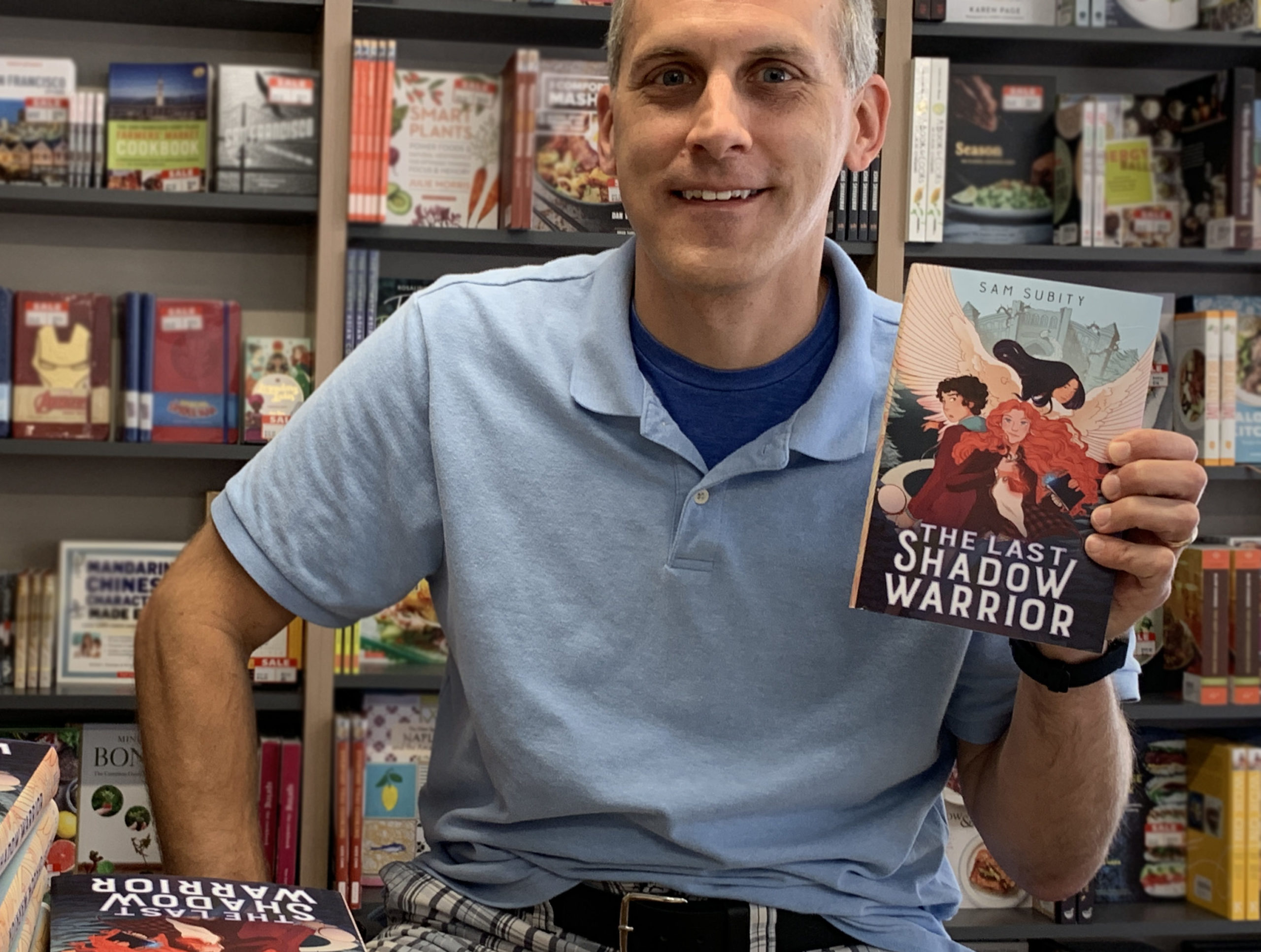The Last Shadow Warrior by Sam Subity is a laugh-out-loud, action-packed adventure about twelve-year-old Abby Beckett who comes from a long line of Viking warriors known as the Aesir. Subity blends humor, action, Norse mythology, and character beautifully to make a story that’s sure to be a hit with middle grade readers. I highly recommend reading it for the joy of the adventure and as a mentor text for your own writing.
Given all the fun action in The Last Shadow Warrior, you might expect a craft post that analyzes the techniques Subity used to create his fabulous action scenes. But it’s Subity’s characters and their relationships that give his debut its emotional resonance, thus providing his readers with a powerful reason to become invested in the story (and those amazing action scenes.)
Since Abby moves from North Carolina to Minnesota early in the book, most of her relationships are new ones that readers watch unfold from the beginning. However, with Abby and her dad, Subity does a beautiful job of bringing their relationship to life through a shared history. In fact, he uses at least five techniques right off the bat to create this deep history (and relationship) between Abby and her dad. I was seriously impressed that he managed to do all of this mostly through snappy dialogue and within the first four pages of The Last Shadow Warrior.
References to Previous Conversations with Shared Knowledge
The first chapter of The Last Shadow Warrior kicks off with Abby in the middle of attempting her own warrior training session with a training dummy that her dad has named Ivar the Boneless. When she asks her father when she can start real warrior training, he reminds her that she’s too young.
“Abby, we’ve talked about this before. Warrior training starts at fourteen. Not my rule.” (2)
Just a simple piece of dialogue, but it actually does some heavy lifting. It works hard to ensure the reader immediately understands the rich shared history and knowledge these two characters have.
It also offers a hefty amount of worldbuilding. There’s warrior training! It starts when someone’s fourteen! There are other people who set the rules! Yes, Subity could have provided us with this information via Abby’s internal thoughts, but it’s so much more organic, authentic, and efficient to reveal it via well-crafted dialogue.
Insider Knowledge
We writers can take the next step and turn our characters’ shared knowledge into insider information, the kind that only really close friends or family know about each other. For instance, parents know their children’s likes and dislikes. If your parent-child dialogue naturally reveals a character’s preferences, your story will feel more authentically steeped in a long shared history, thus making the story more believable.
Abby’s father says:
“I didn’t come down here to annoy you. Really. Just wanted to let you know I’m going to run down to the store and pick up a couple things. I could get you something. Maybe some cookie dough ice cream? The kind you like with the fudge in the middle?” (2)
This relatively innocuous piece of dialogue right at the beginning of the book reassures readers that these two characters have lived together for a while and know each other well. Plus, this reference to ice cream is setting up more dialogue that will reinforce that this particular day requires some serious coping.
Shared Rituals
People who know each other well often share rituals with each other. Family members may have celebrations that follow the same routine year after year. Friends might have favorite activities together. Rituals tell us a lot about the people who partake in them, and often the ritual acts as a surrogate for a particular emotion, such as grief, or love. In the following dialogue not only do we learn about a longstanding ritual that Abby and her father have on the anniversary of her mom’s death, but it also gives us final confirmation that Abby’s mom is, in fact, dead.
“Hey,” [Dad] said as he stood, “we’re still doing our usual thing in her memory tonight, right? A batch of my famous banana chocolate chip pancakes. Then watch The Princess Bride for, what is it, the three hundred ninety-fifth time?”
I smiled and nodded. “Twenty-third. And, you know, if you just happened to find some of that ice cream you mentioned, that wouldn’t be a bad thing.” (3)
In-Jokes
Another way to reveal how characters relate to each other is through in-jokes. Already, Abby’s thoughts have hinted that the only person who truly “got” her was gone and that their family wasn’t normal. Her dad has also made reference to the fact that her mom isn’t “here to help [Abby] with this stuff.” (3).
When he jokes about the only thing his daughter learned from him, the reader gets enough information to conclude that Abby follows after her deceased mom in most things. Her mom’s the tree and she’s the acorn. Her dad says:
“The one thing my daughter learns from me is drowning her problems in copious amounts of sugar.” (3)
As the story progresses, arguably, we do see that Abby shares her dad’s sense of humor and his commitment to never giving up. But right away, through a simple in-joke, we learn the critical information that Abby is following in her mom’s footsteps, not her dad’s.
Specific Details That Reinforce Two Characters’ History Together
Finally, well-thought-out, very specific details can say a lot about characters and their relationship by reinforcing a shared history and informing character development. Bonus points if these details are important elements in the plot too. Subity uses the detail of a squeaky step, something that’s been part of Abby and her dad’s life for years, to do all of the above.
The detail of a squeaky step is introduced as something that Abby’s dad has been trying and trying to fix (shared history). It implies that her dad is the kind of guy who tries to fix things, the kind of guy who will use both philosophy and humor when he can’t fix things, and he’s maybe the kind of guy who won’t ask someone else to fix things (character development).
I listened as he walked the rest of the way up the stairs, including the one that squeaked every time. [Dad] kept trying to fix it but said it remained hopelessly incorrigible. His footsteps echoed down the hall, then the front door opened and closed. (4)
Doubling down on character development, Subity’s use of the specific phrase, “hopelessly incorrigible,” gives us a sense for Abby’s dad’s voice. His charming and extensive vocabulary hints at his vocation as an English teacher. The way that Abby focuses on every step her dad takes until he leaves the house tells the reader how important he is to her.
A page later, Abby hears a THUMP and then a SMASH. When she decides she has to investigate, she’s forced to confront that same staircase with its squeaky step. Now that squeaky step acts as a plot element to up the tension of the scene. Arguably, it also acts as a metaphor for the fact that her dad is not going to save the day in this novel. He wasn’t able to fix the squeaky step, and he’s not going to be the one to save Abby from everything she’s about to face moving forward. She’s going to have to save herself.
I forced myself up one step, then another, placing my foot carefully each time, starting with the balls of my feet and then silently rolling my heel downward like Mom had trained me. About midway up, I remembered the squeaky step. Which one was it again? The fourth from the top. I think. Or was it the fifth? Ugh. I couldn’t remember. Could I somehow vault over both of them? Likely I’d end up falling down the stairs and making an even bigger racket. Okay: eeny, meeny, miny…
CREEEEEAAAAK! (6)
Now that’s a well-thought-out, very specific detail that’s worth having.
Now It’s Your Turn
Bottom line, if your characters have a past together, you can use dialogue and specific details to efficiently reinforce their shared history as it pertains to the plot, which will help your readers’ connect to your characters and become invested in your story. Look for opportunities in your own work-in-progress to tell the story of your character relationships:
- Let your characters slip in important references to previous conversations that may have happened years or days before your story begins.
- Reveal insider knowledge through dialogue that reinforces the depth of a particular relationship.
- Create a shared ritual that your characters can participate in that by definition has been happening long before the story began.
- Brainstorm in-jokes (and then pick the very best) to pepper your story with.
- And finally, think about how your specific details might reveal something about the relationship between two characters in addition to doing character development and/or moving the plot forward.
If you enjoyed this post analyzing one aspect of character development, you may enjoy these posts that focus on other aspects of character development.
Kristi Wright (co-editor) writes picture books and middle grade novels. Her goal as a writer is to give children a sense of wonder, a hopefulness about humanity, and a belief in their future. She is represented by Kurestin Armada at Root Literary. She is an active volunteer for SCBWI and a 12 X 12 member. Find her at www.kristiwrightauthor.com and on Twitter @KristiWrite.



COMMENTs:
0